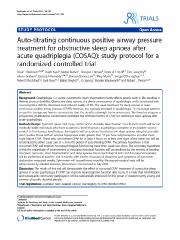Please use this identifier to cite or link to this item:
https://ahro.austin.org.au/austinjspui/handle/1/11793| Title: | Auto-titrating continuous positive airway pressure treatment for obstructive sleep apnoea after acute quadriplegia (COSAQ): study protocol for a randomized controlled trial. | Austin Authors: | Berlowitz, David J ;Ayas, Najib;Barnes, Maree ;Brown, Douglas J;Cistulli, Peter A;Geraghty, Tim;Graham, Alison;Lee, Bonsan Bonne;Morris, Meg;O'Donoghue, Fergal J ;Rochford, Peter D ;Ross, Jacqueline M ;Singhal, Balraj;Spong, Jo;Wadsworth, Brooke;Pierce, Robert J | Affiliation: | Institute for Breathing and Sleep, Austin Health, Heidelberg, Victoria, Australia | Issue Date: | 19-Jun-2013 | Publication information: | Trials 2013; 14(): 181 | Abstract: | Quadriplegia is a severe, catastrophic injury that predominantly affects people early in life, resulting in lifelong physical disability. Obstructive sleep apnoea is a direct consequence of quadriplegia and is associated with neurocognitive deficits, sleepiness and reduced quality of life. The usual treatment for sleep apnoea is nasal continuous positive airway pressure (CPAP); however, this is poorly tolerated in quadriplegia. To encourage patients to use this therapy, we have to demonstrate that the benefits outweigh the inconvenience. We therefore propose a prospective, multinational randomized controlled trial of three months of CPAP for obstructive sleep apnoea after acute quadriplegia.Specialist spinal cord injury centres across Australia, New Zealand, the UK and Canada will recruit medically stable individuals who have sustained a (new) traumatic quadriplegia (complete or incomplete second cervical to first thoracic level lesions). Participants will be screened for obstructive sleep apnoea using full, portable sleep studies. Those with an apnoea hypopnoea index greater than 10 per hour will proceed to an initial three-night trial of CPAP. Those who can tolerate CPAP for at least 4 hours on at least one night of the initial trial will be randomized to either usual care or a 3-month period of auto-titrating CPAP. The primary hypothesis is that nocturnal CPAP will improve neuropsychological functioning more than usual care alone. The secondary hypothesis is that the magnitude of improvement of neuropsychological function will be predicted by the severity of baseline sleepiness measures, sleep fragmentation and sleep apnoea. Neuropsychological tests and full polysomnography will be performed at baseline and 3 months with interim measures of sleepiness and symptoms of autonomic dysfunction measured weekly. Spirometry will be performed monthly. Neuropsychological tests will be administered by blinded assessors. Recruitment commenced in July 2009.The results of this trial will demonstrate the effect of nocturnal CPAP treatment of obstructive sleep apnoea in acute quadriplegia. If CPAP can improve neurocognitive function after injury, it is likely that rehabilitation and subsequent community participation will be substantially improved for this group of predominantly young and severely physically disabled people.Australian New Zealand Clinical Trial Registry ACTRN12605000799651. | Gov't Doc #: | 23777510 | URI: | https://ahro.austin.org.au/austinjspui/handle/1/11793 | DOI: | 10.1186/1745-6215-14-181 | ORCID: | 0000-0002-2562-1829 | Journal: | Trials | URL: | https://pubmed.ncbi.nlm.nih.gov/23777510 | Type: | Journal Article | Subjects: | Acute Disease Australia Autonomic Nervous System.physiopathology Canada Clinical Protocols Continuous Positive Airway Pressure Great Britain Humans Neuropsychological Tests New Zealand Polysomnography Predictive Value of Tests Prospective Studies Quadriplegia.complications.physiopathology.psychology Quality of Life Questionnaires Research Design Sleep Sleep Apnea, Obstructive.diagnosis.etiology.physiopathology.psychology.therapy Spirometry Time Factors Treatment Outcome |
| Appears in Collections: | Journal articles |
Files in This Item:
| File | Description | Size | Format | |
|---|---|---|---|---|
| 23777510.pdf | 311.96 kB | Adobe PDF |  View/Open |
Page view(s)
144
checked on Apr 26, 2025
Download(s)
140
checked on Apr 26, 2025
Google ScholarTM
Check
Items in AHRO are protected by copyright, with all rights reserved, unless otherwise indicated.
